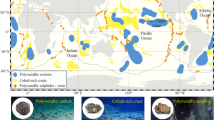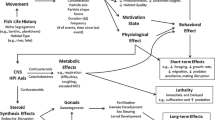Abstract
A new approach has been applied to studying marine sedimentation using dispersed sedimentary material in sediment traps compared to the surface layer of bottom sediments. Based on long-term studies of a small sea of the Arctic Ocean, it was possible to establish new sedimentary patterns in the conditions of the Subarctic and Arctic zones. The monthly, seasonal, and long-term dynamics of the main components of fluxes of dispersed sedimentary material have been studied. The marine stage of sedimentation of the main components of dispersed sedimentary material over time is discussed; it is shown that the biogenic component of the flux decreases by an order of magnitude when passing from dispersed to concentrated forms. The average values of the vertical fluxes are calculated: the total and those of the contributions of the main biogenic and terrigenous components per 1 m2 of the bottom and over the entire deep sea area of the White Sea.





Similar content being viewed by others
REFERENCES
L. V. Il’yash, L. S. Zhitina, and V. D. Fedorov, Phytoplankton of the White Sea (Yanus-K, Moscow, 2003) [in Russian].
M. A. Levitan, “Sedimentation rates in the Arctic Ocean during the last five marine isotope stages,” Oceanology (Engl. Transl.) 55, 425–433 (2015).
A. P. Lisitzin, The fluxes of matter and energy in the external and inner spheres of the Earth,” in Global Environmental Changes (Siberian Branch, Russian Academy of Sciences, Novosibirsk, 2001), pp. 163–249.
M. V. Mityaev, M. V. Gerasimova, and L. G. Pavlova, “Suspended Matter and fluxes of sediments in the bays of Karelian coast in 2016–2018,” Tr. Kol’sk. Nauchn. Tsentra, Ross. Akad. Nauk 10 (3), 5–13 (2019).
A. N. Novigatsky, A. P. Lisitzin, A. A. Klyuvitkin, et al., “Vertical fluxes of suspended sedimentary matter in Arctic sedimentogenesis of intracontinental seas,” Dokl. Earth Sci. 479, 384–389 (2018).
A. N. Pantyulin, “Dynamics, structure, and water masses,” in The White Sea System, Vol. 2: Water Column and Interacting Atmosphere, Cryosphere, River Run-Off, and Biosphere, Ed. by A. P. Lisitzin (Nauchnyi Mir, Moscow, 2012), pp. 309–379.
E. A. Romankevich, Biogeochemistry of Organic Matter of the Arctic Seas (Nauka, Moscow, 1982) [in Russian].
R. Aliev, V. Bobrov, S. Kalmykov, et al., “Natural and artificial radionuclides as a tool for sedimentation studies in the Arctic region,” J. Radioanal. Nucl. Chem. 274, 315–321 (2007).
V. Y. Berger and I. M. Primakov, “Assessment of primary production in the White Sea,” Russ. J. Mar. Biol. 33, 49–53 (2007).
M. Bringué and A. Rochon, “Late Holocene paleoceanography and climate variability over the Mackenzie slope (Beaufort Sea, Canadian Arctic),” Mar. Geol. 291, 83–96 (2012).
L. L. Demina, D. F. Budko, A. N. Novigatsky, et al., “Occurrence forms of heavy metals in the bottom sediments of the White Sea,” in Sedimentation Processes in the White Sea: The White Sea Environment, Ed. by A. P. Lisitzin and L. L. Demina, Environment Handbook of Environmental Chemistry Series vol. 82 (Springer-Verlag, New York, 2018), Part 2, pp. 241–270.
K. Fahl and E. M. Nöthig, “Lithogenic and biogenic particle fluxes on the Lomonosov Ridge (central Arctic Ocean) and their relevance for sediment accumulation: vertical vs. lateral transport,” Deep Sea Res., Part I 54 (8), 1256–1272 (2007).
V. V. Gordeev, “Fluvial sediment flux to the Arctic Ocean,” Geomorphology 80 (1), 94–104 (2006).
S. Honjo and K. W. Doherty, “Large aperture time-series sediment traps; design objectives, construction and application,” Deep-Sea Res., Part A 35 (1), 133–149 (1988).
L. V. Ilyash, I. G. Radchenko, V. P. Shevchenko, et al., “Spatial distribution of phytoplankton in the White Sea in the late summer period with regard to the water structure and dynamics,” Oceanology (Engl. Transl.) 51, 993–1003 (2011).
L. V. Ilyash, I. G. Radchenko, A. N. Novigatsky, et al., “Vertical flux of phytoplankton and particulate matter in the White Sea according to the long-term exposure of sediment traps,” Oceanology (Engl. Transl.) 53, 192–199 (2013).
M. D. Kravchishina, V. P. Shevchenko, A. S. Filippov, et al., “Composition of the suspended particulate matter at the Severnaya Dvina River mouth (White Sea) during the spring flood period,” Oceanology (Engl. Transl.) 50, 365–385 (2010).
M. Kravchishina, A. Klyuvitkin, A. Filippov, et al., “Suspended particulate matter in the White Sea: the results of long-term interdisciplinary research,” Proc. Int. Assoc. Hydrol. Sci. 365, 35–41 (2015).
M. D. Kravchishina, A. P. Lisitsyn, A. A. Klyuvitkin, et al., “Suspended particulate matter as a main source and proxy of the sedimentation processes,” in Sedimentation Processes in the White Sea: The White Sea Environment, Ed. by A. P. Lisitzin and L. L. Demina, Environment Handbook of Environmental Chemistry Series vol. 82 (Springer-Verlag, New York, 2018), Part 2, pp. 13–48.
C. Lalande, E. M. Nöthig, R. Somavilla, et al., “Variability in under-ice export fluxes of biogenic matter in the Arctic Ocean,” Global Biogeochem. Cycles 28 (5), 571–583 (2014).
A. Y. Lein, M. D. Kravchishina, N. V. Politova, et al., “Transformation of particulate organic matter at the water-bottom boundary in the Russian Arctic seas: evidence from isotope and radioisotope data,” Lithol. Miner. Resour. 47, 99–128 (2012).
A. P. Lisitzin, Sea-Ice and Iceberg Sedimentation in the Ocean: Recent and Past (Springer-Verlag, Berlin, 2002).
A. P. Lisitzin, “Sediment fluxes, natural filtration, and sedimentary systems of a “living ocean,” Russ. Geol. Geophys. 45, 15–48 (2004).
A. P. Lisitzin, “Marine ice-rafting as a new type of sedimentogenesis in the Arctic and novel approaches to studying sedimentary processes,” Russ. Geol. Geophys. 51, 12–47 (2010).
A. P. Lisitzin, A. N. Novigatsky, V. P. Shevchenko, et al., “Dispersed organic matter and its fluxes in oceans and seas from the example of the White Sea: results of a 12-year study,” Dokl. Earth Sci. 456, 635–639 (2014).
A. P. Lisitzin, A. N. Novigatsky, R. A. Aliev, et al., “Comparative study of vertical suspension fluxes from the water column, rates of sedimentation, and absolute masses of the bottom sediments in the White Sea basin of the Arctic Ocean,” Dokl. Earth Sci. 465, 1253–1256 (2015).
A. P. Lisitzin, A. N. Novigatsky, and A. A. Klyuvitkin, “Seasonal variation of fluxes of dispersed sedimentary matter in the White Sea (Arctic ocean basin),” Dokl. Earth Sci. 465, 1182–1186 (2015).
A. P. Lisitzin, A. N. Novigatsky, V. P. Shevchenko, et al., “Dynamics of the main components of fluxes of sedimentary matter in the White Sea,” Dokl. Earth Sci. 472, 252–255 (2017).
V. N. Lukashin, K. N. Kosobokova, V. P. Shevchenko, et al., “Results of multidisciplinary oceanographic studies in the White Sea in June 2000,” Oceanology (Engl. Transl.) 43, 224–239 (2003).
V. N. Lukashin, A. B. Isaeva, T. N. Rat’kova, and R. Prego, “Particulate matter and vertical particle fluxes in the White Sea,” Oceanology (Engl. Transl.) 43, 159–172 (2003).
V. N. Lukashin, A. A. Klyuvitkin, A. P. Lisitzin, and A. N. Novigatsky, “The MSL-110 small sediment trap,” Oceanology (Engl. Transl.) 51, 699–703 (2011).
M. V. Mityaev, M. V. Gerasimova, and E. I. Druzhkova, “Vertical particle fluxes in the coastal areas of the Barents and White Seas,” Oceanology (Engl. Transl.) 52, 112–121 (2012).
A. N. Novigatsky, A. A. Klyuvitkin, and A. P. Lisitsyn, “Vertical fluxes of dispersed sedimentary matter, absolute masses of the bottom sediments, and rates of modern sedimentation,” in Sedimentation Processes in the White Sea: The White Sea Environment, Ed. by A. P. Lisitzin and L. L. Demina, Environment Handbook of Environmental Chemistry Series vol. 82 (Springer-Verlag, New York, 2018), Part 2, pp. 49–66.
N. M. Pertzova and K. N. Kosobokova, “Zooplankton of the White Sea. History of investigations and the present state of knowledge—a review,” Ber. Polarforschung 359, 23–29 (2000).
N. V. Politova, A. A. Klyuvitkin, A. N. Novigatsky, et al., “Early diagenesis in recent bottom sediments of the Dvina Bay (White Sea),” Oceanology (Engl. Transl.) 56, 702–713 (2016).
V. Rachold, H. Eicken, V. V. Gordeev, et al., “Modern terrigenous organic carbon input to the Arctic Ocean,” in The Organic Carbon Cycle in the Arctic Ocean, Ed. by R. Stein and R. W. Macdonald (Springer-Verlag, Berlin, 2004), pp. 33–41.
V. R. Shevchenko, Y. S. Dolotov, N. N. Filatov, et al., “Biogeochemistry of the Kem’ River estuary, White Sea (Russia),” Hydrol. Earth Syst. Sci. 9 (1–2), 57–66 (2005).
V. P. Shevchenko, O. S. Pokrovsky, A. S. Filippov, et al., “On the elemental composition of suspended matter of the Severnaya Dvina River (White Sea region),” Dokl. Earth Sci. 430, 228–234 (2010).
R. Stein, Arctic Ocean Sediments: Processes, Proxies, and Paleoenvironment (Elsevier, Amsterdam, 2008), Vol. 2.
A. A. Vetrov and E. A. Romankevich, “Primary production and fluxes of organic carbon to the seabed in the Eurasian arctic seas, 2003–2012,” Dokl. Earth Sci. 454, 44–46 (2014).
P. Wassmann, E. Bauerfeind, M. Fortier, et al., “Particulate organic carbon flux to the Arctic Ocean sea floor,” in The Organic Carbon Cycle in the Arctic Ocean, Ed. by R. Stein and R. W. Macdonald (Springer-Verlag, Berlin, 2004), pp. 101–138.
G. Wefer and G. Fischer, “Annual primary production and export flux in the Southern Ocean from sediment trap data,” Mar. Chem. 35 (1–4), 597–613 (1991).
Funding
Processed of the material supported by the Russian Science Foundation (grant no. 19-17-00234); determination of organic carbon was supported by the Russian Foundation for Basic Research (project no. 19-05-00022); interpretation of the obtained data was carried out as part of the state task of IO RAS for 2019–2020 (topic no. 0149-2019-0007).
Author information
Authors and Affiliations
Corresponding author
Rights and permissions
About this article
Cite this article
Novigatsky, A.N., Lisitzin, A.P., Shevchenko, V.P. et al. Sedimentogenesis in the White Sea: Vertical Fluxes of Suspended Particulate Matter and Absolute Masses of Bottom Sediments. Oceanology 60, 372–383 (2020). https://doi.org/10.1134/S0001437020030078
Received:
Revised:
Accepted:
Published:
Issue Date:
DOI: https://doi.org/10.1134/S0001437020030078




